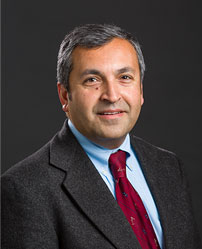 Breaking large classes into small groups has been used as an educational tool for centuries, but recently the practice has garnered increased attention in higher education. Studies have focused on the demonstrable benefits of cooperative learning, on its usefulness for problem-solving in science courses, and practical methods to implement it in classes. Here at Yale University, Professor Mayur Desai uses small groups in his graduate-level Master of Public Health classes and has a lot to say about their effectiveness.
Breaking large classes into small groups has been used as an educational tool for centuries, but recently the practice has garnered increased attention in higher education. Studies have focused on the demonstrable benefits of cooperative learning, on its usefulness for problem-solving in science courses, and practical methods to implement it in classes. Here at Yale University, Professor Mayur Desai uses small groups in his graduate-level Master of Public Health classes and has a lot to say about their effectiveness.
As an Associate Professor of Epidemiology in the Yale School of Public Health, Desai directs the one-year Advanced Professional MPH Program and teaches courses on epidemiologic research methods and data analysis. He coordinates the “Clinical and Health Services Research Methods” course for Yale’s National Clinician Scholars Program and teaches the quantitative methods portion of the curriculum.
He began using small groups more often in recent years, appreciating their effectiveness in getting students to actively participate, emphasize skills over content, and build a sense of community in class. “When I use small groups in class, or in breakout rooms on Zoom,” says Desai, “I get responses to the open-ended questions that I normally might not.”
One of the collaborative learning strategies that Professor Desai likes to use is the “think-pair-share” method, which requires students to individually think about a topic or answer a question, and then pair up with another student to share their ideas or answer. This allows every student an opportunity to engage with the material and learn from their peers.
Another strategy that Desai has found effective is putting students into small groups (usually 4-5 students) and having them answer a series of focused questions: for example, questions to sharpen their critique of a published epidemiologic study. “To avoid having some members of a group dominate the discussion, I tell the groups to start by quietly thinking about the answers and then begin their discussion, allowing each member of the group to take the lead on a different question,” he explains. “This allows students who may need a little more time to formulate their answers or may be reticent to fully participate an opportunity to do so, contributing to a more inclusive learning environment.” When the class comes back together, a different group takes the lead to kick off the discussion for a particular question. As with the “think-pair-share” method, the goal is to have students be active learners who are engaging with the material and with one another.
Some faculty worry about how to fairly grade these kinds of small groups. However, Desai has not found this to be a problem. “I never grade participation,” he says. “I give students many opportunities to participate and don’t feel like it is necessary.” He also designates a random spokesperson from each group to help avoid the challenge posed by a few extroverted over-contributors.
Another challenge to using small-group work is that it can leave less time for other learning. Reorganizing lecture content via pre-recorded videos is one way to deal with the problem, allowing students to dig into more challenging content together. “Class feels less lecture-driven and students like it,” he says of this method. “They can watch my lectures at their own pace, on their own time, and come to class already familiar with the content.”
Desai’s experience shows that there are many benefits to group work, including making the most of in-person time and emphasizing application of skills. “It is a great way to get to know your students, and help your students know each other,” he says in conclusion. That alone may be worth the effort.
